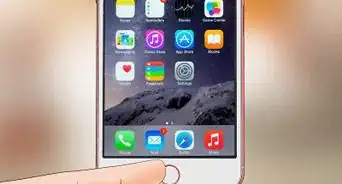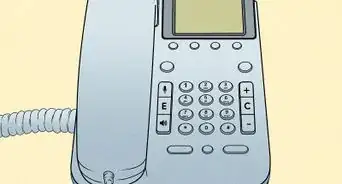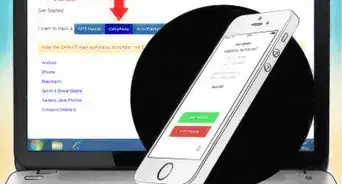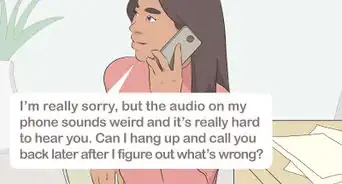wikiHow is a “wiki,” similar to Wikipedia, which means that many of our articles are co-written by multiple authors. To create this article, 21 people, some anonymous, worked to edit and improve it over time.
There are 8 references cited in this article, which can be found at the bottom of the page.
This article has been viewed 169,288 times.
Learn more...
The World Health Organization has announced on May 31, 2011 that cell phones can possibly cause cancer and as a result, have listed cell phones as a "carcinogenic hazard", in the same category with lead and engine exhaust.[1] The peer-reviewed study consisting of 31 scientists from 14 different countries found evidence for an increase in some brain cancers (Glioma and acoustic neuroma), cancers that take a while to develop and the scientists fear that long-term usage could result in more of these types of cancer.[2] [3]
Cell phones communicate using signals in the microwave spectrum. The invisible stream of RF (radio frequency) signals penetrate our bodies when the device is held close, and as well as the long-term potential for cancer, there is also the potential to impact cognitive memory functions and to cause disorientation and dizziness. This article explains how to take precautions when using your cell phone.
Steps
-
1Balance the safety and convenience. While there have been ample studies showing that there may be side effects to cell phone usage, there have been many studies refuting the health impacts, causing a large level of uncertainty and misunderstanding. It's human nature to keep using something that works for us unless proven hazardous, so this uncertainty has worked in favor of continued, increased use of cell phones. Understandably so too – cell phones are convenient, they allow you to find people fast, do business anywhere, and stay in touch around the world. However, they are also a "massive human experiment", with more than 2-4 billion people in the world experiencing 70 to 80 percent of the cell phone's energy penetrating the skull, with unknown long-term outcomes.[4] [5] When weighing up this convenient tool with the questionable health impact, do you want to take this risk with your health? Choosing to err on the side of caution and taking measures to reduce your exposure to radio frequency (RF) emissions from your cell phone is a good preventative health action over which you have control.
-
2Return to the cord phone or land-line phone. Try taking most of your calls using the "old-fashioned" way of a phone plugged into the wall. If you like pacing as you talk, get a longer cord. At least make a large effort to take calls that you know will last a long time on a corded phone for your day-to-day communications.
- Don't substitute it with a cordless phone for long conversations. These have their own questionable health impacts. For example, digital cordless phones radiate continuously even when they're not in use.[6]
Advertisement -
3Limit the length of your calls on your cell phone. Prolonged extended use of cell phones increases your exposure to the radiated signals from your device; even a two minute call has been shown to alter your brain's natural electrical activity for up to an hour afterward.[7] By reducing the amount of time spent on the cell phone and by relegating it to emergency use, you can reduce your exposure to it. Turn it off and keep it in a carrying bag, away from your body but handy should you need to use it.
-
4Use a hands-free device or wireless headset to increase the distance between the phone and your head. The best approach to using a cell phone to create distance between you and the radiating phone. When speaking, place the phone on speakerphone. The speakerphone option is a good one because it allows you to hold the phone away from you as you speak.
- Use texting more often than talking to keep the cell phone away from the head. However, even texting should be kept to a minimum. And keep the cell phone away from your body while emailing or texting.[8]
- Keep the phone away from you when dialing to connect. Phones use more radiation during connection time, so just watch the screen and then move the phone to listen once you're sure the connection has occurred.[9]
-
5Stay still when using a cell phone. If you keep moving around with it, more radiation is emitted because the phone needs to keep track of you.[10] This covers walking and being inside a vehicle; as you move, the phone continues to scan to keep up with the changes in position.
-
6Turn the cell phone off when not in use. A cell phone that is in standby mode is still emitting radiation. When it is off, this ceases. Do not carry the cell phone next to your body; instead, keep it in a bag. This is especially important if you have become used to wearing it in a pocket next to your groin; research has shown that men wearing cell phones next to their groin have up to a 30 percent reduction in sperm count.[11] Keep it away from all vital organs (heart, liver, etc.).
-
7Consider either not giving cell phones to children or limiting their usage to emergency circumstances. Keep in mind that children are more susceptible to the radiation emitted from the cell phone. Their skulls are thinner and their brains are less developed. Moreover, since they are growing, their cells divide at a much faster rate, which means that the impact of radiation can be a lot worse.[12]
-
8Look for products designed to shield you as a cell phone user. There are several devices on the market offering their own claims. Read the information accompanying the products and decide what is likely to work best for you. Some of the possibilities include:
- A cell phone EMF protective device. These are small chips or buttons that are adhered to the phone reducing the impact of the transmitter signals.
- A screen type shield. This is a screen placed over the phone's earpiece.
-
9Purchase a cell phone that rates as low as possible on the scale of radiation emissions. Some cell phones are definitely better than others on this scale, so as a consumer, vote with your purchase power and let cell phone companies know that less radiation is what consumers demand.
- You can work out the rate of radio frequency being absorbed by the body by checking out the Specific Absorption Rate (SAR) for your brand of phone at the US FCC website here: http://transition.fcc.gov/cgb/sar/. Click on the brand names to see how your existing phone stacks up.
- The less fancy your phone, the less energy it needs to run, and the less radiation you'll be exposed to. It may sound disappointing if you're used to playing on your phone a lot but that's what laptops, portable game consoles, and iPads are for!
Community Q&A
-
QuestionHow can I protect my eyes while using a mobile phone?
 Sango LamCommunity AnswerDon't use your phone in the dark because it will strain your eyes.
Sango LamCommunity AnswerDon't use your phone in the dark because it will strain your eyes. -
QuestionWill there only be effects if I put a phone near my head when I call?
 Community AnswerBecause they are resonating with your brain cells it may be harmful, but the effect is getting smaller: distance ^3 to be accurate.
Community AnswerBecause they are resonating with your brain cells it may be harmful, but the effect is getting smaller: distance ^3 to be accurate. -
QuestionWhich side of my head should I keep my cell phone on during a call?
 Community AnswerIt doesn't matter which side. However, if you use your cellphone a lot, you may want to change ears every so often.
Community AnswerIt doesn't matter which side. However, if you use your cellphone a lot, you may want to change ears every so often.
Warnings
- Don't make calls when the signal strength is weak. The weaker the signal, the harder the phone must work to make a connection, thereby emitting more energy.⧼thumbs_response⧽
- Avoid using a cell phone when sick or pregnant. Illness can reduce your ability to cope with radiation, while a baby in utero might be impacted by the radiation.⧼thumbs_response⧽
- Don't use a cell phone when driving. It is a highly dangerous distraction that causes accidents, injury, and death.⧼thumbs_response⧽
- If you decide to dispose of your cell phone to change it for one with lower radiation or to stop using one at all, have it properly recycled rather than passing it on to someone else.⧼thumbs_response⧽
- The regular wired headset that comes with the phone has been shown to intensify the radiation in the ear canal. Don't use it![14] Use a wireless headset instead.⧼thumbs_response⧽
- Research upon which the safety guidelines have been developed for RF emissions (radio frequency emissions) cannot rule out the possibility of phone RF causing head tumors after 10 to 20 years of use. As such, finding out either way will still take time but in the meantime, adopting a cautious approach to cell phone usage is good for your health.⧼thumbs_response⧽
- Don't make calls when you're enclosed in metal, such as inside the car or an elevator. The metal causes the radiation to reflect back on all occupants (the Faraday Cage effect).[15]⧼thumbs_response⧽
Things You'll Need
- Wireless headset
- Cell phone shields
- Reminders to yourself to help you change current cell phone habits
- More corded phones (long cords if needed, plus ties for the cords to keep them out of the way when not in use)
References
- ↑ http://edition.cnn.com/2011/HEALTH/05/31/who.cell.phones/index.html
- ↑ http://edition.cnn.com/2011/HEALTH/05/31/who.cell.phones/index.html
- ↑ http://www.who.int/en/
- ↑ Liz Armstrong, Guy Dauncey, and Anne Wordsworth, Cancer: 101 Solutions to a Preventable Epidemic, p. 49, (2007), ISBN978-0-86571-542-4
- ↑ http://www.who.int/en/
- ↑ Liz Armstrong, Guy Dauncey, and Anne Wordsworth, Cancer: 101 Solutions to a Preventable Epidemic, p. 85, (2007), ISBN978-0-86571-542-4
- ↑ http://www.dailymail.co.uk/health/article-1392810/Mobile-phones-CAN-increase-cancer-risk-Shock-finding-major-study.html?ito=feeds-newsxml
- ↑ http://www.dailymail.co.uk/health/article-1392810/Mobile-phones-CAN-increase-cancer-risk-Shock-finding-major-study.html?ito=feeds-newsxml
- ↑ http://www.dailymail.co.uk/health/article-1392810/Mobile-phones-CAN-increase-cancer-risk-Shock-finding-major-study.html?ito=feeds-newsxml
- ↑ http://www.dailymail.co.uk/health/article-1392810/Mobile-phones-CAN-increase-cancer-risk-Shock-finding-major-study.html?ito=feeds-newsxml
- ↑ http://www.dailymail.co.uk/health/article-1392810/Mobile-phones-CAN-increase-cancer-risk-Shock-finding-major-study.html?ito=feeds-newsxml
- ↑ http://edition.cnn.com/2011/HEALTH/05/31/who.cell.phones/index.html
- ↑ Liz Armstrong, Guy Dauncey, and Anne Wordsworth, Cancer: 101 Solutions to a Preventable Epidemic, p. 85, (2007), ISBN978-0-86571-542-4
- ↑ http://www.dailymail.co.uk/health/article-1392810/Mobile-phones-CAN-increase-cancer-risk-Shock-finding-major-study.html?ito=feeds-newsxml
- ↑ http://www.dailymail.co.uk/health/article-1392810/Mobile-phones-CAN-increase-cancer-risk-Shock-finding-major-study.html?ito=feeds-newsxml
- Liz Armstrong, Guy Dauncey, and Anne Wordsworth, Cancer: 101 Solutions to a Preventable Epidemic, p. 49, (2007), ISBN978-0-86571-542-4 – research source
- WHO, http://www.who.int/en/ – source of media release entitled IARC Classified Radiofrequency Electromagnetic Fields As Possibly Carcinogenic To Humans
- CDC, More information on EMF at http://www.cdc.gov/niosh/topics/emf/



































































